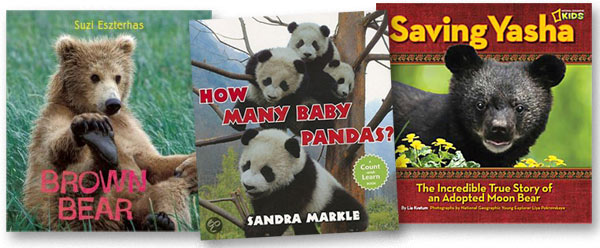The Bear Facts: Books About Cuddly Creatures | Nonfiction Booktalker

Cozy, cuddly, cute—yes, I’m talking about bears. Penguins may be popular, but bears are perennial. And K–4 readers can virtually cuddle away when they stare at the bruins in these colorful books.
Lia Kvatum’ s Saving Yasha: The Incredible True Story of an Adopted Moon Bear (National Geographic, 2012) introduces us to a cub whose mother was killed by hunters in eastern Russia. A group of scientists rescued Yasha and two black bear cubs, and then spent two years teaching them how to live in the wild, replicating what their mothers would have done. The cubs began in a specially built house and then slowly ventured out to explore and climb in the surrounding woods. The scientists wore special clothes that covered up their smell. They didn’t interact with the cubs, but made plenty of notes. Their goal was to integrate them fully into the wild, not make them comfortable around human beings. Show your booktalk listeners the photos of Yasha and her playmates romping. Irresistible!
When the baby bears in Suzi Eszterhas’s Brown Bear (Frances Lincoln, 2012) are born in Alaska in the dead of winter, it’s so cold they don’t leave their den until spring. They need two straight years being cared for and taught by their mother, who never leaves their side. The games they play teach them basic survival skills, most excitingly how to fish. At first, the mom has to fish for her entire family. Catching your dinner in the water is tricky.
Eszterhas’s book explores the full growing cycle of the bears. When the cubs are two and a half, their mother leaves—and in another 12 months, they separate from each other. Looking at the great photo of the two nearly fully grown bears fighting, it’s hard to believe it’s only make-believe.
Although pandas aren’t considered “true” bears by biologists, young readers, as well as adults, think of them as members of the same family. Joanne Ryder’s Panda Kindergarten (HarperCollins, 2009) and Sandra Markle’s How Many Baby Pandas? (Walker, 2009) open windows on the lives of panda cubs growing up in Wolong Nature Preserve in south-central China. A peculiar panda problem: the mothers can take care of only one cub at a time. Usually, when twins are born, one will die, but not at this special nature center. The mom’s cub is switched every week, so each cub gets the attention it needs. When the pandas are old enough to be separated from their mothers, they go to panda kindergarten. Ask your booktalk audience if that sounds like a fun class to attend.
Did you know that almost no one in North America had ever seen a panda until 80 years ago? The creatures were considered legends like the Loch Ness monster. But William Harkness, an American millionaire, decided to head to China and find out for himself. Unfortunately, he died early in the expedition in Shanghai, but his wife, Ruth, carried on his mission. Alicia Potter’s Mrs. Harkness and the Panda (Knopf, 2012), with beautiful pastel illustrations by Melissa Sweet, describes the journey the American fashion designer took up the Yangtze River to find a panda.
On the surface, Ruth didn’t seem the adventurous type, but she had astonishing luck. She found a healthy baby panda and brought it back to Illinois. Apparently, she never worried about the baby’s poor mother, or how it would survive. She named the cub Su Lin, which means “a little bit of something very cute” in Chinese.
Su Lin lived only a year and a half. Afterward, she was stuffed and placed in the Field Museum of Chicago, where tourists still flock to visit her. Su Lin’s story is a great topic of discussion for your audience. Every zoo wants a panda. People love to see them. Ask if it’s right to move pandas away from their native home, away from their families, so we can “ooh” and “aah” over them. All of these insightful books are fine choices to implement the Common Core. And as a friend of mine said, these books are so cute they make your teeth hurt!
RELATED
The job outlook in 2030: Librarians will be in demand
The job outlook in 2030: Librarians will be in demand
ALREADY A SUBSCRIBER? LOG IN
We are currently offering this content for free. Sign up now to activate your personal profile, where you can save articles for future viewing






Add Comment :-
Be the first reader to comment.
Comment Policy:
Comment should not be empty !!!